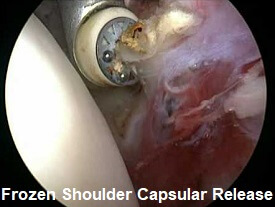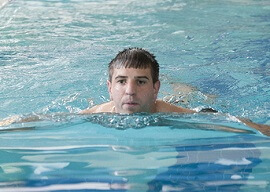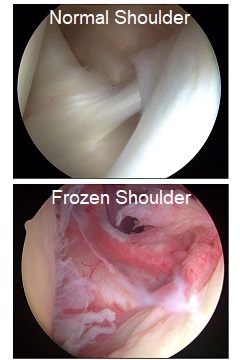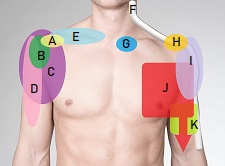- Home
- Common Shoulder Problems
- Frozen Shoulder
- Frozen Shoulder Surgery
Frozen Shoulder Surgery
Written By: Chloe Wilson BSc (Hons) Physiotherapy
Reviewed By: SPE Medical Review Board
Frozen shoulder surgery is recommended for people with ongoing, severe problems with a frozen shoulder aka adhesive capsulitis.
Adhesive capsulitis is common problem caused by inflammation of the joint capsule leading to pain and stiffness in the shoulder.
In most cases, a frozen shoulder is a self-limiting condition, which means that it gets better by itself, but it can take up to two years to fully recover, sometimes longer.
The first line of treatment for a frozen shoulder is exercises, painkillers and injections, but if these fail to work and symptoms continue, then surgery may be recommended.
There are three different types of frozen shoulder surgery performed:
- Manipulation Under Anaesthetic (MUA),
- Capsular Release
- Arthrographic Distension
Here we will start by having a quick look at what is going on with a frozen shoulder and then concentrate on what happens during each type of surgery and the recovery process.
What Is A Frozen Shoulder?
The shoulder is a ball and socket joint. Surrounding the joint is the joint capsule, a bag-like structure that continues fluid to lubricate and nourish the joint.
The capsule is elastic to allow for the arm to move freely in multiple directions but with a frozen shoulder, the capsule thickens and tightens, restricting arm movement. Not all cases of shoulder stiffness are caused by a frozen shoulder.
The classic presentation of adhesive capsulitis is a progressive three phase process:
- Painful Phase: The shoulder is painful to move but the movement is not restricted
- Freezing Phase: The shoulder becomes increasingly stiff but pain levels reduce
- Thawing Phase: Symptoms gradually subside until you regain full, pain-free movement.
Each phase can last for a number of months and it can take up to two years to fully recovery. If symptoms fail to improve, then frozen shoulder surgery may be recommended, but only once the shoulder is fully frozen. Before this, surgery is unlikely to be successful as the movement gained will most likely be lost as the shoulder continues to freeze.
You can find out more about the causes, symptoms and treatment options in the adhesive capsulitis section.
Types of Frozen Shoulder Surgery
The three most common types of frozen shoulder surgery are:
1. Manipulation Under Anaesthetic (MUA)
A manipulation under anaesthetic is a common option for frozen shoulder surgery which doesn't actually involve cutting into the shoulder.
With an MUA, you are put to sleep under general anaesthetic. A nerve block may also be used to numb your shoulder to help reduce post-op pain. The surgeon forcibly moves your shoulder in different directions which stretches and sometimes tears the tight capsule to allow freer movement of the shoulder.
Abduction (moving the arm out to the side) is performed first to stretch the inferior capsule, then adduction (across the body) to stretch the posterior capsule. Finally internal and external rotation are performed to regain the twisting movements of the shoulder.
Some people opt for this type of frozen shoulder surgery as it is non-invasive.
2. Capsular Release

A capsular release is the most common type of invasive frozen shoulder surgery. The surgeon makes small incisions around the shoulder so they can access the joint, known as an arthroscopy or keyhole surgery. This is done under general anaesthetic
Saline solution (a mixture of sterile water and salt) is pumped into the shoulder joint through a tube to stretch the capsule and allow a clear view inside the joint.
A flexible tube with a tiny camera, about 3.5mm wide, known as an arthroscope is introduced so the surgeon can see the structures inside the joint, either by looking through the scope directly, or via a monitor.
The surgeon can then accurately see where the scar tissue, adhesions and inflammation are. Special microsurgery instruments such as a radiofrequency thermal probe are inserted and used to release the capsule.
The surgeon may then forcibly stretch and manipulate the shoulder to ensure maximum movement is regained (MUA). Capsular release frozen shoulder surgery takes around one hour. You may also be given a nerve block or steroid injection into the joint to help with post-operative pain.
3. Arthrographic Distension
Arthrographic distension frozen shoulder surgery is carried out under local anaesthestic, meaning you are awake during the procedure, and only takes about fifteen minutes.
With arthrographic distension, also referred to as hydrodilatation, a special dye is injected into the shoulder joint so the surgeon can see the joint under radiographic imaging, either x-ray or ultrasound.
The surgeon injects a mixture of saline, steroid and local anaesthetic into the shoulder, usually up to around 40mls. The fluid expands (distends) the joint which is thought to break down scar tissue and adhesions, thus freeing up the joint.
Whilst arthrographic distension can be helpful in the frozen/thawing phases of adhesive capsulitis, in particularly stubborn cases MUA or capsular release tend to have a better long term outcome.This may be a good option if you don’t want to have a general anaesthetic, but the procedure can be quite uncomfortable because the capsule is being stretched so much.
Your surgeon will advise you as to which type of frozen shoulder surgery is best for you.
Recovering From Frozen Shoulder Surgery
Frozen shoulder surgery doesn't end when the surgeon has finished their part. Following MUA or capsular release frozen shoulder surgery, you will be taken to the recovery room until the effects of the anaesthesia wear off, which usually takes a couple of hours.
Your physical therapist will see you almost immediately, moving your arm to show you how much movement you have regained – this doesn’t hurt due to the nerve block or injection. They will give you lots of advice and an exercise program to do to help ensure you keep all the shoulder movement you have gained during your frozen shoulder surgery. You can usually go home later the same day.
Most people make a full recovery following frozen shoulder surgery and here are out top tips for the recovery process to help you get the best results:
1. Pain Relief

With your frozen shoulder surgery you may be given a nerve block. This helps reduce post-operative pain, but it also reduces your sensation so can make it difficult to move your arm – don’t worry, this is normal and the effects wear off after 12-48 hours (if it doesn’t, contact your doctor).
You will be prescribed various pain relieving medication which you should take regularly the first few days, even if you aren’t experiencing any pain, to stop the pain building up. It can take up to an hour for the medication to work so if you wait until you have pain to take the medication you will find it harder to manage your symptoms than if you take it regularly.
It is much better to take pain relief regularly so that you can move your arm, rather than trying to manage without medication and using your arm less because of the pain. After a few days you can gradually wean yourself off the medication as comfortable.
Some people find it useful to use ice packs to help reduce pain and inflammation, but this should not be done until you have regained full sensation in your shoulder and arm. Wrap a bag of frozen peas, or an ice pack, in a towel and place it over your shoulder for 10-15 minutes (no longer). If you have had a capsular release it is important to keep the wounds dry until they have healed so place the wrapped ice pack in a plastic bag to ensure the wound does not get wet.
2. Using A Sling
You may be given a sling to wear initially after frozen shoulder surgery to help support the arm and make it more comfortable. You can take your arm in and out of the sling as you like, indeed you will need to take it off regularly to do exercises. Try not to rely on the sling too much – it is really important to get your arm moving as soon as possible to prevent the shoulder stiffening up again.
Some people find it helpful to wear their sling in bed the first few nights, particularly those who sleep on their side. Alternatively, use a pillow to support the arm.
3. Shoulder Exercises
Shoulder and arm exercises are the key to getting the best results from frozen shoulder surgery and should be started immediately. The shoulder will have been well stretched out during the procedure, but it is vital to do exercises regularly to keep that movement otherwise the capsule will quickly tighten up again
Your physical therapist will show you how much movement you have regained immediately after surgery by moving your arm and give you exercises that you can do at home. You will need to do these a few times each day for a number of weeks/months.
Top Tips
- Don't Panic: Once the nerve block has worn off, it is normal form your shoulder to stiffen slightly – don’t worry, it doesn’t mean the frozen shoulder is coming back. It is normal to feel some discomfort and/or stretching when doing your exercises, don’t worry, you aren’t damaging your shoulder.
- Exercise, Exercise, Exercise: It is really important to get as much movement as you can, even if it is sore as you do the exercises, to stop the shoulder stiffening up. However, if you get intense pain that last more than half an hour, cut back on the number of repetitions and how far you move the arm until you are working at a more manageable level.
- Short & Sharp: It works best to do short sessions, regularly (3-4 times per day) rather than one or two longer sessions. You are aiming to gradually increase how far you move your arm and the number of repetitions to help you regain full movement.
- Don't Quit: Be prepared to stick at it – frozen shoulder surgery on its own won’t fix the stiffness in the long term, exercises are vital to keep the movement. You are the only person who can do them so be prepared to work hard.
You can find a whole range of suitable exercises to do after any type of frozen shoulder surgery in the frozen shoulder exercises section.
Remember, exercising regularly is key to getting the best results from your frozen shoulder surgery. Some movements will improve more quickly than others. Reaching your hand behind your back is often the last movement to return.
Most people notice a real change in their shoulder movement after around 4-6 weeks, as the post-operative pain settles. It can be tempting to stop exercises too early – don’t settle for 80% improvement, keep going and aim for 95-100%!
4. Wound Care
If you have had capsular release frozen shoulder surgery, there will be 2 or 3 small wounds from the arthroscopy which will have special plaster strips over them - stitches aren’t required as the wounds are so small.
You need to keep the wounds dry until they are fully healed, which usually takes around 5-7 days. Either stick to strip washes or if you want to bathe or shower cover the wounds with plastic wrap/cling film or a plastic bag to keep them dry.
5. Driving
You will need to arrange for someone to drive you home after your frozen shoulder surgery. Most people are ready to start driving again within about one week.
You need to be able to safely control and manoeuvre your car so start with short journeys. It is also a good idea to inform your car insurance provider about your operation in case there are any restrictions on your policy.
6. Returning To Work
If you have a fairly sedentary job such as office work, you can usually return to work around one week after your frozen shoulder surgery. If you have more of a manual job or do lots of lifting, you may need a couple of weeks off.
Your doctor and physical therapist will be able to advise you on when you can return.
7. Hobbies/Leisure Activities

The only thing you need to avoid following frozen shoulder surgery is keeping your shoulder still! There is no need to avoid anything, unless it really hurts. Your physical therapist will be able to advise you on when you can return to certain activities.
It is best to start with short sessions to see how you feel both during the session and also the next day. You can start swimming as soon as the wounds have healed – you may find breast stroke more comfortable initially.
How Long Does It Take To Recover?
Frozen shoulder surgery is successful in approximately 70-80% of patients. Everyone progresses at different rates and it can take a number of months to fully recover.
Some people will continue to have a small amount of ongoing stiffness, or in rare cases, the adhesive capsulitis may return, particularly if you are diabetic. Most people recover full movement (or at least 95%) within 6 months. Remember, being diligent with your exercises will lead to the best outcome.
What Else Can Help?
Frozen shoulder surgery is only performed if other treatments have failed. Most cases will resolve on their own eventually with a combination of exercises, injections and time – visit the adhesive capsulitis section for more information.
Whatever type of frozen shoulder surgery you have, it is really important to do exercises regularly after the procedure to regain full movement as the shoulder – visit the frozen shoulder exercises section for a whole range of suitable exercises. Remember, it can take a few months to fully recover from frozen shoulder surgery so keep going with your exercises – it will be worth all the effort.
Related Articles
Page Last Updated: November 5th, 2024
Next Review Due: November 5th, 2026




